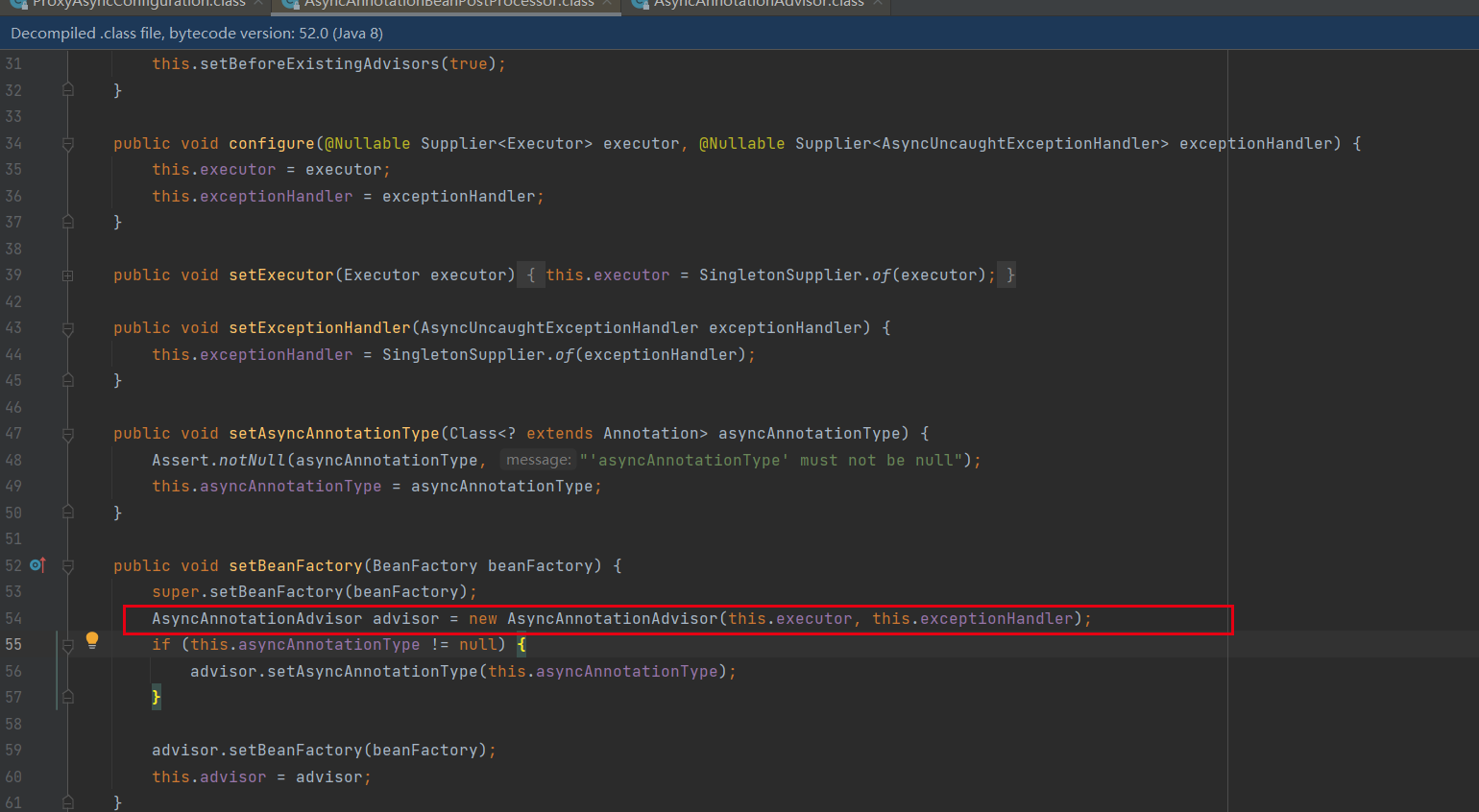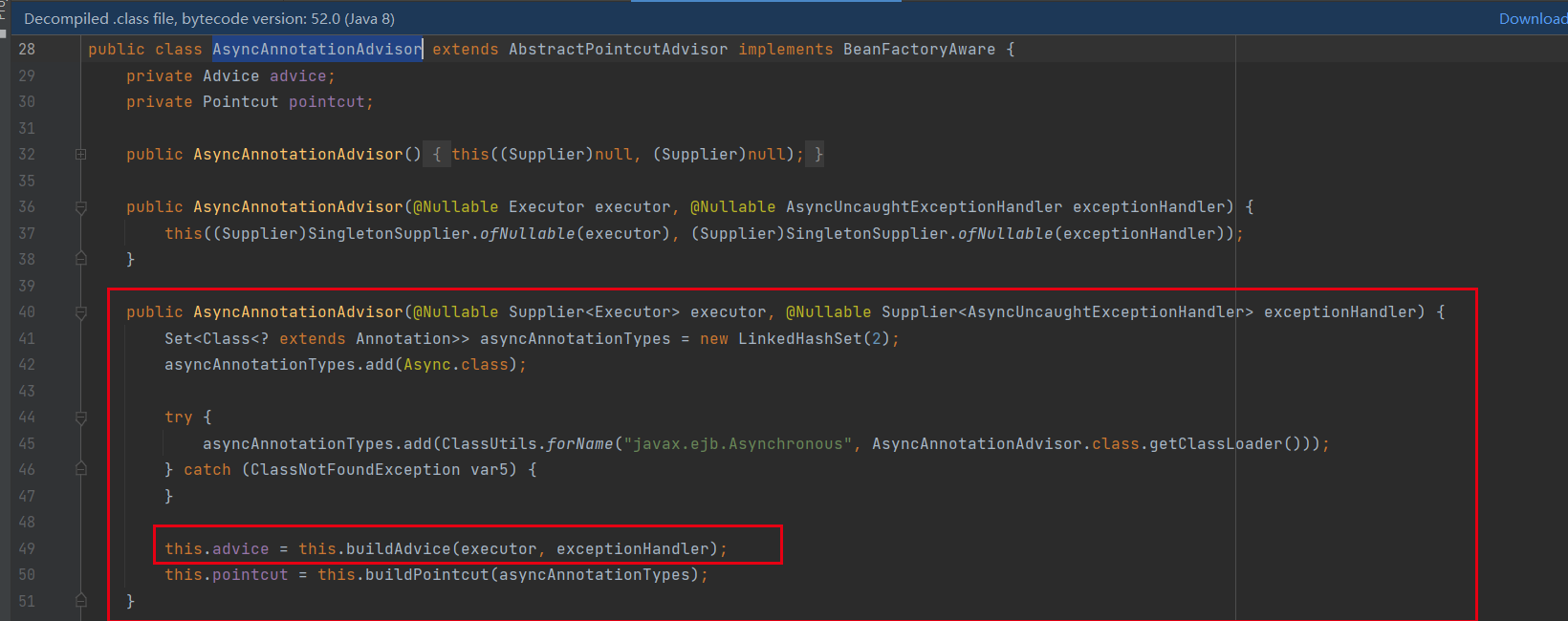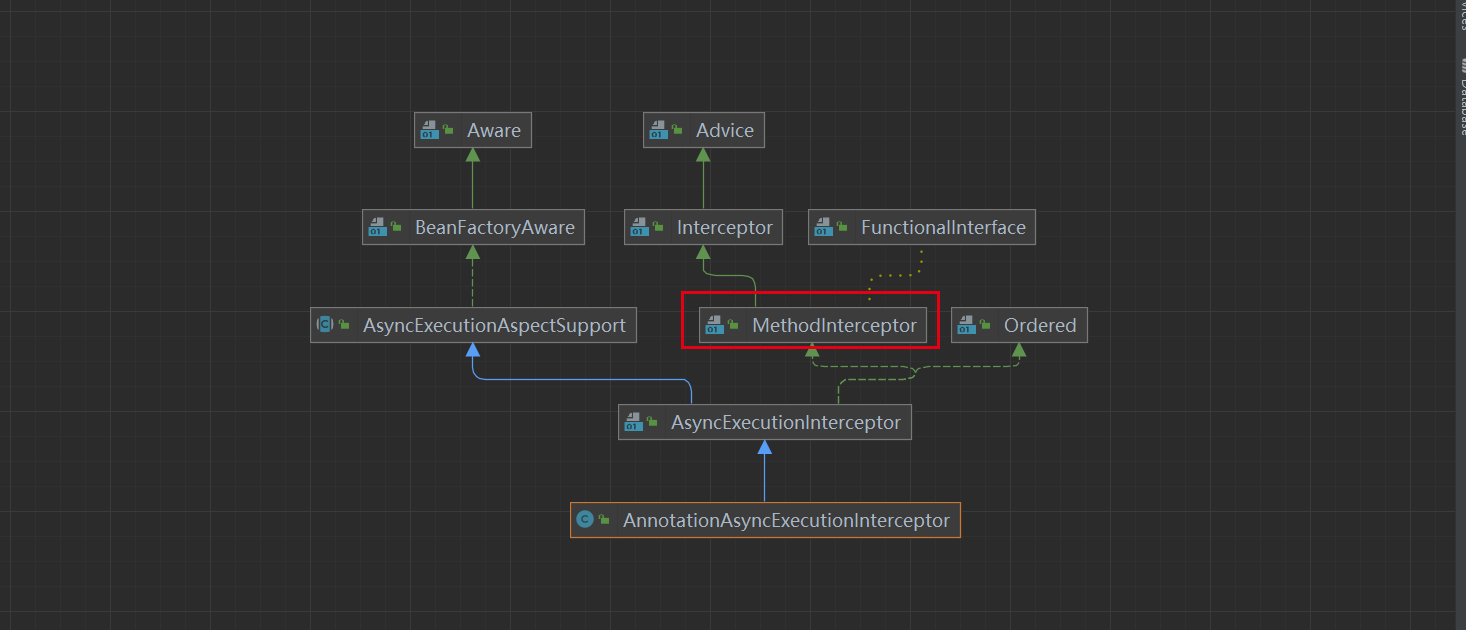Spring提供了@Async异步注解,该注解可以被标注在方法上,以便异步地调用该方法。
@Target({ElementType.TYPE, ElementType.METHOD})
@Retention(RetentionPolicy.RUNTIME)
@Documented
public @interface Async {
/**
* A qualifier value for the specified asynchronous operation(s).
* <p>May be used to determine the target executor to be used when executing
* the asynchronous operation(s), matching the qualifier value (or the bean
* name) of a specific {@link java.util.concurrent.Executor Executor} or
* {@link org.springframework.core.task.TaskExecutor TaskExecutor}
* bean definition.
* <p>When specified on a class-level {@code @Async} annotation, indicates that the
* given executor should be used for all methods within the class. Method-level use
* of {@code Async#value} always overrides any value set at the class level.
*
* @since 3.1.2
*/
String value() default "";
}@Async的基本应用
// 开启异步支持
@EnableAsync
@SpringBootApplication(exclude = DataSourceAutoConfiguration.class)
public class IntlCommonApplication {
public static void main(String[] args) {
SpringApplication.run(IntlCommonApplication.class, args);
}
}
@RestController
public class TestController {
@Resource
private AsyncTestService asyncTestService;
@RequestMapping("/test")
public String test(){
asyncTestService.test();
System.out.println("目标方法执行完了吗?");
return "OK";
}
}
@Service
public class AsyncTestServiceImpl implements AsyncTestService {
// 标记异步方法
@Async
@Override
public void test() {
try {
TimeUnit.SECONDS.sleep(20);
} catch (InterruptedException e) {
e.printStackTrace();
}
System.out.println("test:" + this.getClass() + "线程:" + Thread.currentThread().getName());
}
}
如果是同步执行,那么控制台打印的顺序应该是Service输出在上,Controller输出在下。通过控制台打印的日志,可以证明异步的注解生效了。
@Async原理解析
test()方法标注了@Async注解,该方法就异步执行了,那么该方法肯定是被拦截了,方法拦截肯定存在一个方法拦截器MethodInterceptor。
@FunctionalInterface
public interface MethodInterceptor extends Interceptor {
@Nullable
Object invoke(@Nonnull MethodInvocation invocation) throws Throwable;
}
方法拦截器是一个接口,对异步方法的拦截,肯定是该接口的一个实现类。那么如何找到这个实现类呢,我们可以从@EnableAsync注解开始分析。
@Target(ElementType.TYPE)
@Retention(RetentionPolicy.RUNTIME)
@Documented
@Import(AsyncConfigurationSelector.class)
public @interface EnableAsync {
/**
* 自定义异步注解,@Async和@javax.ejb.Asynchronous默认是会被检测到的
*/
Class<? extends Annotation> annotation() default Annotation.class;
/**
* 表示是否使用子类代理(CGLIB)还是基于接口的代理(JDK代理)
*/
boolean proxyTargetClass() default false;
/**
* 表示使用哪种advice,PROXY是基于代理的,另外一种是切面织入形式的
*/
AdviceMode mode() default AdviceMode.PROXY;
/**
* 表示AsyncAnnotationBeanPostProcessor这个后置处理器的应用顺序
*/
int order() default Ordered.LOWEST_PRECEDENCE;
}
@Import注解导入了AsyncConfigurationSelector类,继承自AdviceModeImportSelector
public class AsyncConfigurationSelector extends AdviceModeImportSelector<EnableAsync> {
private static final String ASYNC_EXECUTION_ASPECT_CONFIGURATION_CLASS_NAME =
"org.springframework.scheduling.aspectj.AspectJAsyncConfiguration";
/**
* 根据@EnableAsync的mode属性返回不同配置类
*/
@Override
public String[] selectImports(AdviceMode adviceMode) {
switch (adviceMode) {
case PROXY:
return new String[] { ProxyAsyncConfiguration.class.getName() };
case ASPECTJ:
return new String[] { ASYNC_EXECUTION_ASPECT_CONFIGURATION_CLASS_NAME };
default:
return null;
}
}
}
/**
* 基于注解的mode属性来获取imports的基类
*/
public abstract class AdviceModeImportSelector<A extends Annotation> implements ImportSelector {
public static final String DEFAULT_ADVICE_MODE_ATTRIBUTE_NAME = "mode";
protected String getAdviceModeAttributeName() {
return DEFAULT_ADVICE_MODE_ATTRIBUTE_NAME;
}
/**
* 获取泛型注解的mode属性,调用子类的selectImports(AdviceMode adviceMode)方法获取import配置类
* AnnotationMetadata importingClassMetadata是SpringBoot启动类的上获取的注解(我当前项目上就@EnableAsync, @SpringBootApplication两个注解), ConfigurationClassParser的processImports方法传进来的
*/
@Override
public final String[] selectImports(AnnotationMetadata importingClassMetadata) {
//获取当前类的泛型参数(我自己Debug时就是@EnableAsync, getClass()获取到的是AsyncConfigurationSelector的class对象)
Class<?> annoType = GenericTypeResolver.resolveTypeArgument(getClass(), AdviceModeImportSelector.class);
//获取指定当前泛型注解属性和值
AnnotationAttributes attributes = AnnotationConfigUtils.attributesFor(importingClassMetadata, annoType);
if (attributes == null) {
throw new IllegalArgumentException(String.format(
"@%s is not present on importing class '%s' as expected",
annoType.getSimpleName(), importingClassMetadata.getClassName()));
}
//获取mode属性值
AdviceMode adviceMode = attributes.getEnum(this.getAdviceModeAttributeName());
//调用子类获取import配置类
String[] imports = selectImports(adviceMode);
if (imports == null) {
throw new IllegalArgumentException(String.format("Unknown AdviceMode: '%s'", adviceMode));
}
return imports;
}
/**
* 根据mode值返回import类完全限定名的数组
*/
protected abstract String[] selectImports(AdviceMode adviceMode);
}
实例化ProxyAsyncConfiguration
@Configuration(
proxyBeanMethods = false
)
@Role(2)
public class ProxyAsyncConfiguration extends AbstractAsyncConfiguration {
public ProxyAsyncConfiguration() {
}
@Bean(
name = {"org.springframework.context.annotation.internalAsyncAnnotationProcessor"}
)
@Role(2)
public AsyncAnnotationBeanPostProcessor asyncAdvisor() {
Assert.notNull(this.enableAsync, "@EnableAsync annotation metadata was not injected");
// 生明异步注解后置处理器
AsyncAnnotationBeanPostProcessor bpp = new AsyncAnnotationBeanPostProcessor();
bpp.configure(this.executor, this.exceptionHandler);
Class<? extends Annotation> customAsyncAnnotation = this.enableAsync.getClass("annotation");
if (customAsyncAnnotation != AnnotationUtils.getDefaultValue(EnableAsync.class, "annotation")) {
bpp.setAsyncAnnotationType(customAsyncAnnotation);
}
bpp.setProxyTargetClass(this.enableAsync.getBoolean("proxyTargetClass"));
bpp.setOrder((Integer)this.enableAsync.getNumber("order"));
return bpp;
}
}ProxyAsyncConfiguration这个类主要是声明了AsyncAnnotationBeanPostProcessor这个Bean,就是异步注解后置处理器,分析其继承体体系,发现其实现了BeanFactoryAware接口,实现该接口的类,spring容器在创建该bean时,会回调:void setBeanFactory(BeanFactory beanFactory) throws BeansException。

AsyncAnnotationBeanPostProcessor
setBeanFactory方法往容器中添加了一个增强器AsyncAnnotationAdvisor

AsyncAnnotationAdvisor
AsyncAnnotationAdvisor的构造器当中执行了buildAdvice增强方法

buildAdvice方法构建的拦截器

AnnotationAsyncExecutionInterceptor
AnnotationAsyncExecutionInterceptor的继承体系

重点看它的父类AsyncExecutionInterceptor

public class AsyncExecutionInterceptor extends AsyncExecutionAspectSupport implements MethodInterceptor, Ordered {
public AsyncExecutionInterceptor(Executor defaultExecutor) {
super(defaultExecutor);
}
public AsyncExecutionInterceptor(Executor defaultExecutor, AsyncUncaughtExceptionHandler exceptionHandler) {
super(defaultExecutor, exceptionHandler);
}
/**
* MethodInterceptor重写的方法,方法调用前后处理一些逻辑
*/
@Override
public Object invoke(final MethodInvocation invocation) throws Throwable {
//获取invocation的目标对象的class对象(被调用的异步方法所属对象的Class对象)
Class<?> targetClass = (invocation.getThis() != null ? AopUtils.getTargetClass(invocation.getThis()) : null);
//通过class对象和invocation的method获取Method
Method specificMethod = ClassUtils.getMostSpecificMethod(invocation.getMethod(), targetClass);
final Method userDeclaredMethod = BridgeMethodResolver.findBridgedMethod(specificMethod);
//通过method获取处理这个异步方法的线程池实例
AsyncTaskExecutor executor = determineAsyncExecutor(userDeclaredMethod);
if (executor == null) {
throw new IllegalStateException(
"No executor specified and no default executor set on AsyncExecutionInterceptor either");
}
//将异步方法封装成一个Callable对象
Callable<Object> task = new Callable<Object>() {
@Override
public Object call() throws Exception {
try {
Object result = invocation.proceed();
if (result instanceof Future) {
return ((Future<?>) result).get();
}
}
catch (ExecutionException ex) {
handleError(ex.getCause(), userDeclaredMethod, invocation.getArguments());
}
catch (Throwable ex) {
handleError(ex, userDeclaredMethod, invocation.getArguments());
}
return null;
}
};
//把异步任务、线程池实例、返回值类型传进去,调用父类的AsyncExecutionAspectSupport的doSubmit方法
return doSubmit(task, executor, invocation.getMethod().getReturnType());
}
/**
* 根据异步方法,获取处理该异步方法的线程池实例的bean名称,后续在BeanFactory里面根据这个名称获取线程池实例,本类中返回null,子类会重写这个方法,AnnotationAsyncExecutionInterceptor重写改方法是获取@Async注解的value值
*/
@Override
protected String getExecutorQualifier(Method method) {
return null;
}
/**
* 调用父类的获取默认线程池实例的方法,如果获取不到,使用SimpleAsyncTaskExecutor实例
* SimpleAsyncTaskExecutor这个线程池会为每个任务触发一个新线程,异步执行它,相当于没用线程池
*/
@Override
protected Executor getDefaultExecutor(BeanFactory beanFactory) {
Executor defaultExecutor = super.getDefaultExecutor(beanFactory);
return (defaultExecutor != null ? defaultExecutor : new SimpleAsyncTaskExecutor());
}
@Override
public int getOrder() {
return Ordered.HIGHEST_PRECEDENCE;
}
}
接下来看AsyncExecutionAspectSupport,它是异步方法执行切面的基类,实现了BeanFactoryWare接口,可以获取Bean工厂,源码如下
public abstract class AsyncExecutionAspectSupport implements BeanFactoryAware {
//线程池默认bean名称
public static final String DEFAULT_TASK_EXECUTOR_BEAN_NAME = "taskExecutor";
//CompletableFuture类是否存在,这个类是java8引入的,这个字段doSubmit方法有用到
private static final boolean completableFuturePresent = ClassUtils.isPresent(
"java.util.concurrent.CompletableFuture", AsyncExecutionInterceptor.class.getClassLoader());
protected final Log logger = LogFactory.getLog(getClass());
//异步方法和对应线程池实例的缓存,因为每个异步方法可以指定线程池实例
private final Map<Method, AsyncTaskExecutor> executors = new ConcurrentHashMap<Method, AsyncTaskExecutor>(16);
//默认的线程池实例
private volatile Executor defaultExecutor;
//未捕获异常的处理器
private AsyncUncaughtExceptionHandler exceptionHandler;
private BeanFactory beanFactory;
public AsyncExecutionAspectSupport(Executor defaultExecutor) {
this(defaultExecutor, new SimpleAsyncUncaughtExceptionHandler());
}
public AsyncExecutionAspectSupport(Executor defaultExecutor, AsyncUncaughtExceptionHandler exceptionHandler) {
this.defaultExecutor = defaultExecutor;
this.exceptionHandler = exceptionHandler;
}
public void setExecutor(Executor defaultExecutor) {
this.defaultExecutor = defaultExecutor;
}
public void setExceptionHandler(AsyncUncaughtExceptionHandler exceptionHandler) {
this.exceptionHandler = exceptionHandler;
}
/**
* 重写BeanFactoryAware接口的方法,设置Bean工厂
*/
@Override
public void setBeanFactory(BeanFactory beanFactory) {
this.beanFactory = beanFactory;
}
/**
* 根据指定异步方法获取对应的线程池实例
*/
protected AsyncTaskExecutor determineAsyncExecutor(Method method) {
//从缓存里面获取,如果获取得到直接返回
AsyncTaskExecutor executor = this.executors.get(method);
if (executor == null) {
Executor targetExecutor;
//根据方法获取线程池实例的Bean名称,@Async的value属性的值
String qualifier = getExecutorQualifier(method);
if (StringUtils.hasLength(qualifier)) {
//bean工厂根据bean名称获取线程池实例
targetExecutor = findQualifiedExecutor(this.beanFactory, qualifier);
}
else {
targetExecutor = this.defaultExecutor;
if (targetExecutor == null) {
synchronized (this.executors) {
if (this.defaultExecutor == null) {
this.defaultExecutor = getDefaultExecutor(this.beanFactory);
}
targetExecutor = this.defaultExecutor;
}
}
}
if (targetExecutor == null) {
return null;
}
//如果不是AsyncListenableTaskExecutor类型的线程池实例,构造一个TaskExecutorAdapter实例,TaskExecutorAdapter是带一个TaskDecorator属性的线程池实例,可以对要执行的任务进行装饰,比如SpringSecurity进行权限管理时,创建异步任务会丢失父线程的权限信息,可以写一个类实现TaskDecorator接口,在decorate方法里面往SecurityContextHolder设置上下文信息
executor = (targetExecutor instanceof AsyncListenableTaskExecutor ?
(AsyncListenableTaskExecutor) targetExecutor : new TaskExecutorAdapter(targetExecutor));
this.executors.put(method, executor);
}
return executor;
}
/**
* 抽象方法,根据异步方法获取线程池bean的名称
*/
protected abstract String getExecutorQualifier(Method method);
/**
* 根据bean名称获取Executor类型的线程池实例
*/
protected Executor findQualifiedExecutor(BeanFactory beanFactory, String qualifier) {
if (beanFactory == null) {
throw new IllegalStateException("BeanFactory must be set on " + getClass().getSimpleName() +
" to access qualified executor '" + qualifier + "'");
}
return BeanFactoryAnnotationUtils.qualifiedBeanOfType(beanFactory, Executor.class, qualifier);
}
//获取默认的线程池实例
protected Executor getDefaultExecutor(BeanFactory beanFactory) {
if (beanFactory != null) {
try {
// 找TaskExecutor类型的线程池实例
return beanFactory.getBean(TaskExecutor.class);
}
catch (NoUniqueBeanDefinitionException ex) {
logger.debug("Could not find unique TaskExecutor bean", ex);
try {
//找名称为taskExecutor的线程池实例
return beanFactory.getBean(DEFAULT_TASK_EXECUTOR_BEAN_NAME, Executor.class);
}
catch (NoSuchBeanDefinitionException ex2) {
if (logger.isInfoEnabled()) {
logger.info("More than one TaskExecutor bean found within the context, and none is named " +
"'taskExecutor'. Mark one of them as primary or name it 'taskExecutor' (possibly " +
"as an alias) in order to use it for async processing: " + ex.getBeanNamesFound());
}
}
}
catch (NoSuchBeanDefinitionException ex) {
logger.debug("Could not find default TaskExecutor bean", ex);
try {
//找名称为taskExecutor的线程池实例
return beanFactory.getBean(DEFAULT_TASK_EXECUTOR_BEAN_NAME, Executor.class);
}
catch (NoSuchBeanDefinitionException ex2) {
logger.info("No task executor bean found for async processing: " +
"no bean of type TaskExecutor and no bean named 'taskExecutor' either");
}
// Giving up -> either using local default executor or none at all...
}
}
return null;
}
/**
* 执行异步任务,参数分别是异步方法执行逻辑、线程池实例、异步方法返回结果
*/
protected Object doSubmit(Callable<Object> task, AsyncTaskExecutor executor, Class<?> returnType) {
//如果是Java8,使用CompletableFuture来执行异步任务
if (completableFuturePresent) {
Future<Object> result = CompletableFutureDelegate.processCompletableFuture(returnType, task, executor);
if (result != null) {
return result;
}
}
//如果返回类型是ListenableFuture调用submitListenable
if (ListenableFuture.class.isAssignableFrom(returnType)) {
return ((AsyncListenableTaskExecutor) executor).submitListenable(task);
}
//如果返回类型是其他的Future类型,直接交给线程池执行
else if (Future.class.isAssignableFrom(returnType)) {
return executor.submit(task);
}
else {
//直接不返回结果
executor.submit(task);
return null;
}
}
//异常处理
protected void handleError(Throwable ex, Method method, Object... params) throws Exception {
//带返回值的直接抛出异常
if (Future.class.isAssignableFrom(method.getReturnType())) {
ReflectionUtils.rethrowException(ex);
}
else {
//异常处理器处理异常,即使再出现异常也不抛出
try {
this.exceptionHandler.handleUncaughtException(ex, method, params);
}
catch (Throwable ex2) {
logger.error("Exception handler for async method '" + method.toGenericString() +
"' threw unexpected exception itself", ex2);
}
}
}
/**
* Java8下执行异步任务的内部类
*/
@UsesJava8
private static class CompletableFutureDelegate {
public static <T> Future<T> processCompletableFuture(Class<?> returnType, final Callable<T> task, Executor executor) {
//如果异步方法返回值不是CompletableFuture类型直接返回null
if (!CompletableFuture.class.isAssignableFrom(returnType)) {
return null;
}
//调用CompletableFuture的supplyAsync方法去执行task任务
return CompletableFuture.supplyAsync(new Supplier<T>() {
@Override
public T get() {
try {
return task.call();
}
catch (Throwable ex) {
throw new CompletionException(ex);
}
}
}, executor);
}
}
}

总结
通过AsyncExecutionAspectSupport源码,我们可以知道线程池会首先通过用户自己配置的为准,找不到就使用默认的线程池,Spring会优先搜索TaskExecutor类型的bean或者名为taskExecutor的Executor类型的bean,如果都不存在的话,会使用SimpleAsyncTaskExecutor(不推荐使用)执行器。所以,我们可以自定义线程池,然后注入spring中,将bean的名字放到@Async注解的value值即可。























 2万+
2万+











 被折叠的 条评论
为什么被折叠?
被折叠的 条评论
为什么被折叠?








